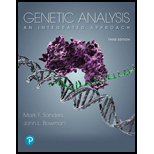
Concept explainers
Identify two general ways chemical mutagens can alter DNA. Give examples of these two mechanisms.
To review:
Analyze how chemical mutagens can alter DNA. Give examples of these two mechanisms of chemical mutation.
Introduction:
Mutation can be defined as a heritable change in the DNA sequence. This change in the DNA sequences either leads to evolutionary change in the DNA, or it changes the gene sequence which disturbs its desirable function and affects the fitness of the organism. Mutation occurs very rarely and randomly. The physical or chemical substance which causes the mutation in the DNA is called the mutagen. Examples of the physical mutagens are radioactive substances, X-rays, and ultraviolet rays, and those of chemical mutagens are Nitrous acid, Acridine, proflavin and Base analogues.
Explanation of Solution
Chemical mutagen is the compound which causes mutation in DNA as it alters the sequence of the DNA. Types of chemical mutation:
1) Base analogue mutation
2) Intercalating agents
3) Deamination
4) Alkylating agents
1) Base analogue mutation: A base analogue is the chemical compound that mimics nitrogen bases and gets incorporated in place of normal base in the DNA. As these compounds are not the true base pair, they possess some different characters of the pairing to the complementary base pair. This wrong incorporation of the nitrogen base in the DNA leads to mutation.
A known example of the base analogue is
2) Intercalating agents: A chemical that loads itself in between the stacked bases of the DNA is called the intercalating agent. This intercalation of chemicals in DNA results in either insertion or deletion of the bases; this results in frameshift mutation of the DNA.
The examples of intercalating agents are Acridine orange, proflavin, and acriflavin. These dyes have a three ringed structure which resembles with purine- pyrimidine base pairing. Purine has a double ring structure while the pyrimidine has a single ring structure; when they pair, they form a three ring structure. When the dyes intercalate into the DNA, it results in the deletion or insertion of the of the DNA replication, therefore frameshift mutation.
A chemical mutagen causes changes in the sequence of the DNA, it is called chemical mutation.
Want to see more full solutions like this?
Chapter 11 Solutions
Genetic Analysis: An Integrated Approach (3rd Edition)
- For short answer questions, write your answers on the line provided. To the right is the mRNA codon table to use as needed throughout the exam. First letter U บบบ U CA UUCPhe UUA UCU Phe UCC UUG Leu CUU UAU. G U UAC TV UGCys UAA Stop UGA Stop A UAG Stop UGG Trp Ser UCA UCG CCU] 0 CUC CUA CCC CAC CAU His CGU CGC Leu Pro CCA CAA Gin CGA Arg CUG CCG CAG CGG AUU ACU AAU T AUC lle A 1 ACC Thr AUA ACA AUG Mot ACG AGG Arg GUU GCU GUC GCC G Val Ala GAC Asp GGU GGC GUA GUG GCA GCG GAA GGA Gly Glu GAGJ GGG AACASH AGU Ser AAA1 AAG Lys GAU AGA CAL CALUCAO CAO G Third letter 1. (+7) Use the table below to answer the questions; use the codon table above to assist you. The promoter sequence of DNA is on the LEFT. You do not need to fill in the entire table. Assume we are in the middle of a gene sequence (no need to find a start codon). DNA 1 DNA 2 mRNA tRNA Polypeptide C Val G C. T A C a. On which strand of DNA is the template strand (DNA 1 or 2)?_ b. On which side of the mRNA is the 5' end (left or…arrow_forward3. (6 pts) Fill in the boxes according to the directions on the right. Structure R-C R-COOH OH R-OH i R-CO-R' R R-PO4 R-CH3 C. 0 R' R-O-P-OH 1 OH H R-C-H R-N' I- H H R-NH₂ \H Name Propertiesarrow_forward4. (6 pts) Use the molecule below to answer these questions and identify the side chains and ends. Please use tidy boxes to indicate parts and write the letter labels within that box. a. How many monomer subunits are shown? b. Box a Polar but non-ionizable side chain and label P c. Box a Basic Polar side chain and label BP d. Box the carboxyl group at the end of the polypeptide and label with letter C (C-terminus) H H OHHO H H 0 HHO H-N-CC-N-C-C N-C-C-N-GC-OH I H-C-H CH2 CH2 CH2 H3C-C+H CH2 CH2 OH CH CH₂ C=O OH CH2 NH2arrow_forward
- please draw in what the steps are given. Thank you!arrow_forwardplease draw in and fill out the empty slots from image below. thank you!arrow_forwardThere is a species of eagle, which lives in a tropical forest in Brazil. The alula pattern of its wings is determined by a single autosomal gene with four alleles that exhibit an unknown hierarchy of dominance. Genetic testing shows that individuals 1-1, 11-4, 11-7, III-1, and III-4 are each homozygous. How many possible genotypes among checkered eagles in the population?arrow_forward
 Human Heredity: Principles and Issues (MindTap Co...BiologyISBN:9781305251052Author:Michael CummingsPublisher:Cengage Learning
Human Heredity: Principles and Issues (MindTap Co...BiologyISBN:9781305251052Author:Michael CummingsPublisher:Cengage Learning BiochemistryBiochemistryISBN:9781305577206Author:Reginald H. Garrett, Charles M. GrishamPublisher:Cengage LearningCase Studies In Health Information ManagementBiologyISBN:9781337676908Author:SCHNERINGPublisher:Cengage
BiochemistryBiochemistryISBN:9781305577206Author:Reginald H. Garrett, Charles M. GrishamPublisher:Cengage LearningCase Studies In Health Information ManagementBiologyISBN:9781337676908Author:SCHNERINGPublisher:Cengage Concepts of BiologyBiologyISBN:9781938168116Author:Samantha Fowler, Rebecca Roush, James WisePublisher:OpenStax College
Concepts of BiologyBiologyISBN:9781938168116Author:Samantha Fowler, Rebecca Roush, James WisePublisher:OpenStax College Biology (MindTap Course List)BiologyISBN:9781337392938Author:Eldra Solomon, Charles Martin, Diana W. Martin, Linda R. BergPublisher:Cengage Learning
Biology (MindTap Course List)BiologyISBN:9781337392938Author:Eldra Solomon, Charles Martin, Diana W. Martin, Linda R. BergPublisher:Cengage Learning Biology 2eBiologyISBN:9781947172517Author:Matthew Douglas, Jung Choi, Mary Ann ClarkPublisher:OpenStax
Biology 2eBiologyISBN:9781947172517Author:Matthew Douglas, Jung Choi, Mary Ann ClarkPublisher:OpenStax





